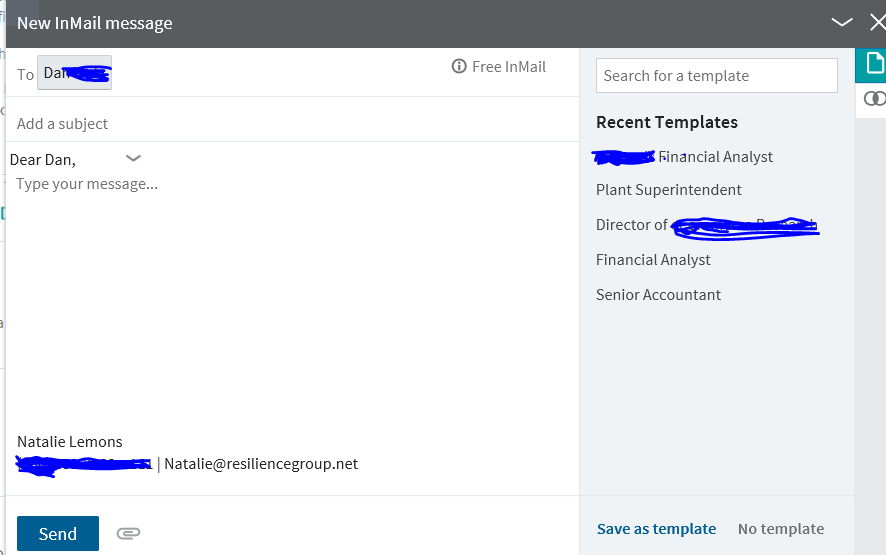Ahh – the InMail. One of the most popular tools for recruiters to reach candidates today. For a recruiter or HR professional, it is sometimes a means of communication they spend several hours a day working on. But did you know that the average open rate ranges between 10-20%? Some recruiters have reported that they receive open rates as high as 70%, so let’s just say the actual rate falls somewhere in between. Why is it that there is such a vast span in the level of response?
According to a LinkedIn report, as many as 78% of LinkedIn users are interested in hearing about opportunities. If your open rate is 10%, that leaves 6 active candidates you aren’t connecting with for every 100 InMails you send out!
Let’s look at what you might be doing wrong.
The Basics Behind Online Messaging
Build Your Brand: LinkedIn, like many other online platforms, are social networks. What are you doing to be social? I don’t mean posting pictures of you at your weekend barbeque. I mean what are you doing to promote your personal BRAND? Or better yet, your company BRAND? Whether you work for a major company, or a small, third party recruiting firm, Employer Branding is extremely important in building credibility. Do you post relevant information? You don’t have to be an author – you can simply share pertinent articles regarding your industry. You can become involved and post (professional) comments, you can join groups. When you send a potential candidate an InMail, chances are they are going to look you up. Professional involvement builds credibility, not only for you, but for your company.
Build a Relationship: As mentioned in my previous article Have We Lost the Art of the Client Relationship?, don’t look at a potential candidate as a commodity! Take the time to understand a little bit about him or her and what their motivator is for looking at your opportunity. It may take a bit more time, but you will build a great deal of trust, and avoid pitfalls in the process.
The “Blast” Should Be a Thing of the Past
Make the Recipient Feel Special: With the latest upgrades to LinkedIn, creating templates and blasting out InMails are not only easy, but are recommended. Even the title of the InMail remains constant.
How is a potential candidate supposed to feel that they are being individually sought out, when the email being sent is very obviously a mass communication? This signals the applicant that you haven’t perused their profile in an in-depth manner, but that you are “shooting blindly”, hoping some people take the bait!
Use a “Catchy” or “Unique” Subject Line: Recruiters are famous for their favorite “clichés”. They go back to them again and again. It has been almost a decade since I worked for an executive search firm, and I can still quote the common phrases used in our office. Candidates hate it. Period. Please DO NOT start your InMails with some of these common ones:
- “Hoping to Touch Base”
- “If You Have a Confidential Minute”
- “Job Opportunity”
- ” I Hope You Are Well (or some version of this)”
- ” Your Dream Job Awaits”
- ” Hope You are Having a Great Day”
- ” If You Have a Quick Minute, Let’s Take This Offline”
- I could go on, but hopefully you get the point! Every recruiter uses them, and every candidate gets that slimy feeling when they read them.
Why Do They Fit the Criteria?
Explain Why They Are Qualified for the Job: This tells the potential candidate that you have done your research, and are familiar with their background. Being ready to explain what qualifications drew you to their profile, based on what your client is looking for also tells candidates that you know your client well. This helps with the next step: overcoming their objections.
Overcome a Candidate’s Objections: Targeting specific candidates and developing a relationship with them gives a recruiter the information (and ammunition) to overcome objections that may arise. What are the issues with their current role that is leading them to look? What other opportunities are they entertaining, and where are they in the process? How does YOUR opportunity compare with the others they are considering: is there more opportunity for advancement, is there greater management potential, is it closer to home? Be prepared to answer questions or concerns that arise.
What’s in It for Them?
Create a Benefit: You need to be educated and prepared to create or fulfill a benefit to your potential candidate. What is their motivation? Your position could pay more money, but is that the driving factor for your candidate? Read more about that in my article on flexibility in the workplace. For many candidates, the ability to work from home trumps title and salary. Building the relationship first will allow for the ease of conversation on this topic. Knowing if what your position offers is a benefit to them will save you time and heartache in the end. If you have covered this topic, you can position yourself to close the candidate.
What If They Still Don’t Respond?
Let’s face it, even under the best of circumstances, the potential candidate you are reaching out to may not respond. He or she may not be active on LinkedIn, or may respond long after it’s too late. So, what are some other strategies you can use to reach out to someone with the ideal profile?
- Follow up – many people reach out once, and never contact the person again. Timing is everything – perhaps they were busy that week, or your email slipped through the cracks.
- Call and leave a message on their voicemail – leave a message and give him or her your number to reach you when it’s convenient. With open work environments, it is often difficult to have a recruiting conversation right at your desk.
- Call the front desk and get their work email. Many times, a LinkedIn profile is connected to a personal account that may not be checked regularly.
- Try emailing again on a weekend. When I first started in the recruiting business, Saturdays were a VERY busy recruiting day. Experimenting with different tactics will provide some benchmarks for determining success.
- Don’t email from a Gmail or Yahoo address. I can’t stress this enough. If you are an independent recruiter, it is incredibly important to have a professional email address. You can sign up with a web hosting service like Bluehost and get an email address. You will own the domain, and can build a website at a later time if you want. It will cost you about $3.95 a month, but will add to your professional brand!
In conclusion, if you are having difficulty with InMail open rates, experiment with different strategies. Every industry is different, so what may work wonders for Marketing candidates may bomb with Engineers. Even when you do find a successful method, don’t be afraid to change it up. You don’t want to get stuck in the “cliché” rut! Fresh approaches are always appreciated! Stick with it!
by Natalie Lemons
Natalie Lemons is the President of the Resilience Group, LLC, and the author of The Resilient Recruiter. Please follow her blog for more articles like this, plus helpful free downloads for recruiters or those starting a Recruiting business. This article may contain affiliate links, but she only endorses products she personally uses.




